Fred Espey of Dun Laoghaire, who has died aged 85, was best-known in sailing as Commodore of the Royal Irish Yacht Club from 2001 to 2004, the culmination of many years of service to the club in a variety of roles. Yet while his quiet-spoken charm and ready hospitality enabled him to fulfil the demanding role of Commodore with the complete support of his wife Eileen, these official duties only temporarily obscured the fact he was very much a man of the Dun Laoghaire waterfront, enjoying the company of others who, like himself, were proficient in the ways of boats and their equipment, and in the skills of the sea.
Although the family home of his boyhood was in Dublin where Ringsend is verging into Ballsbridge and he went to school in St Andrew’s, he lived for the summers spent in Dun Laoghaire with relatives whose house was next door to the legendary “gentleman boatbuilder” Skee Gray. In Skee’s workshop, young Fred was soon acquiring boatbuilding skills which he continued to practice for much of his long life.
The first boat he owned was the Water Wag Phyllis, his ownership being possible as she was bought in a near-derelict state. With Skee Gray’s training, he was able to make her good as new. Then in the early 1960s he turned his attention to the very neglected 17-footer Rosemary which Buddy Thompson – who was noted for sailing bare-footed in a bowler hat and with his toenails painted red for regattas – had not sailed for many years.
It took some time to extract Rosemary from her eccentric owner, but then a winter of work in the Coal Harbour Boatyard by Fred and some friends brought her back to pristine condition in what was effectively a re-build, and he was so fond of his little keelboat that he kept her even when all the other Seventeens had long since ceased to be DBSC 17s, having crossed Dublin Bay to return to being Howth 17s.
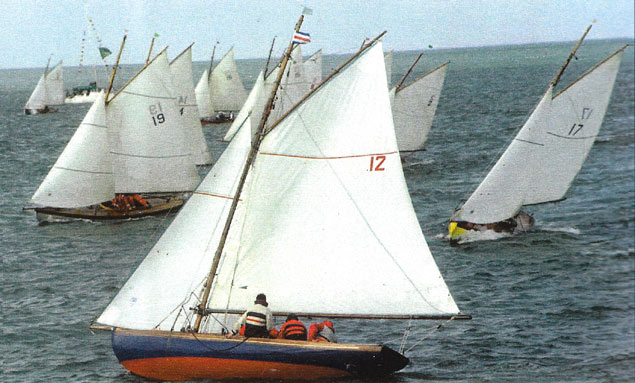 The 17-Footer Rosemary, originally built in 1907 by James Kelly of Portrush, which Fred Espey personally re-built in the early 1960s. It was his second re-build – he’d already completed a successful project on a Water Wag. And it wasn’t until 1971 that Rosemary – the last 17-footer in Dun Laoghaire – was finally sold by him across Dublin Bay to join her sisters in Howth. Photo courtesy Howth 17-Footer Assoc.
The 17-Footer Rosemary, originally built in 1907 by James Kelly of Portrush, which Fred Espey personally re-built in the early 1960s. It was his second re-build – he’d already completed a successful project on a Water Wag. And it wasn’t until 1971 that Rosemary – the last 17-footer in Dun Laoghaire – was finally sold by him across Dublin Bay to join her sisters in Howth. Photo courtesy Howth 17-Footer Assoc.
Finally, in 1971 he sold Rosemary to Howthmen George Curley and Davy Jones, who still own her. But back in Dun Laoghaire which was now his home, Fred Espey had been making preparations for married life with Eileen McNulty by ensuring that, three weeks before the wedding, he acquired the little gaff cutter Jem, which he moored off the Royal Irish YC. He liked the reassurance of having his own boat, particularly in the face of impending domesticity, but in truth he was so able in a boat that he could get sailing in a variety of craft any time he liked, and for some time he had been a regular crewman aboard Punctilio, the last Dublin Bay 25 to be based in Dun Laoghaire. To balance that, his first excursion into Bermudan-rigged ownership was with several years of DBSC racing with the wooden International Dragon Ariadne.
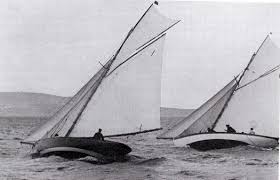 The Dublin Bay 25s – established 1898 – in their racing prime. Among Fred Espey’s many sailing experiences was a regular crewing position aboard W B Stephen’s Punctilio, the last DB 25 to be based in Dublin Bay. Photo courtesy DBSC
The Dublin Bay 25s – established 1898 – in their racing prime. Among Fred Espey’s many sailing experiences was a regular crewing position aboard W B Stephen’s Punctilio, the last DB 25 to be based in Dublin Bay. Photo courtesy DBSC
He enjoyed being in the sea as much as being on it, and for many decades he was a daily swimmer at the Forty Foot - at the time of his death, he was President and Chairman of the 1890-established Sandycove Bathers Association, and had been for many years. But being Fred Espey, he carried this interest in swimming a stage further by developing proficiency in diving, so much so that it was he who discovered the giant anchor on the seabed of Dun Laoghaire Harbour which was lifted by Paddy Murphy, boatman at the RIYC, and is now on permanent display at the National Maritime Museum.
His professional career was in the marketing of animal feeds, a job which meant that outside work, he returned to boats and the sea with even more enthusiasm. He always seemed to have several boat-related projects on the go at one time, and in 1964 when Paul Campbell’s lovely Arthur Robb-designed yawl Verve was under construction with Tyrrell’s of Arklow to be the special boat for the yard’s centenary that year, it was Fred Espey who was asked to be Owner’s Representative throughout the building.
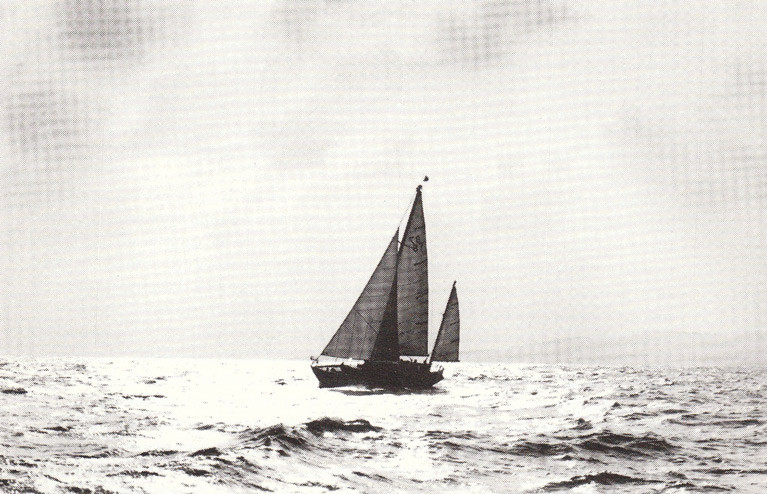 The classic Arthur Robb yawl Verve in Autumn sunshine in Dublin Bay. In 1964, Fred Espey was Owner’s Representative during the building of Verve to become the Centenary Boat at Tyrrell’s of Arklow
The classic Arthur Robb yawl Verve in Autumn sunshine in Dublin Bay. In 1964, Fred Espey was Owner’s Representative during the building of Verve to become the Centenary Boat at Tyrrell’s of Arklow
Then when the much-travelled Verve was completed and cruising extensively, Fred’s quietly reassuring presence, the epitome of able seamanship, was always welcome on board, and he was elected a member of the Irish Cruising Club in 1978. Aboard Verve, another regular crewmember was James Osborne, and when Paul Campbell finally relinquished Verve, he left her to the Espey/Osborne partnership which throve happily for many years and then expanded with extra members such as Michael Boyd to take on the handsome Bowman 46 Hibernia, whose cruises included a Transatlantic passage with Fred Espey in command.
The breadth of his knowledge of boats and how they function was further demonstrated when Dublin Bay SC decided to take a pioneering step in acquiring a catamaran for their Committee Boat. This in time became Mac Lir, and one of the prime movers in the project, Fintan Cairns, recalls that a first port of call for advice was an informative and detailed conversation with his friend Fred Espey.
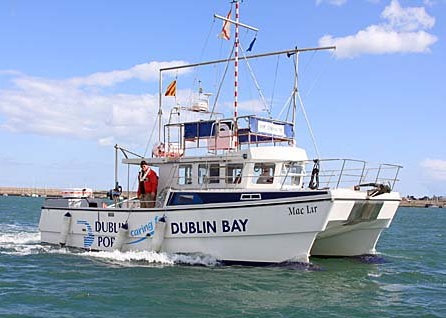 When Dublin Bay SC decided to develop the then-revolutionary concept of a catamaran Committee Boat, one of the first people they turned to for technical advice on the boat which eventually became Mac Lir was Fred Espey. Photo courtesy DBSC
When Dublin Bay SC decided to develop the then-revolutionary concept of a catamaran Committee Boat, one of the first people they turned to for technical advice on the boat which eventually became Mac Lir was Fred Espey. Photo courtesy DBSC
He retired from the animal feeds business while still young enough to develop his interest in diving into an underwater contracts business, but as ever there were unexpected spinoffs. One day in checking moorings in Dun Laoghaire Harbour, he discovered the long-sunken hull of a 19ft Squib keelboat. Nobody was interested in claiming it, so in his spare time, he renovated it completely and then assembled a rig from the remains of a broken Dragon mast.
It says everything about Fred Espey’s continuing joy in sailing that if a free day happened to come long, he’d sail this rescued boat single-handed if needs be, but if a shipmate such as Peter Fleming were available, they’d pop down the coast to Bray for a spot of lunch in the Harbour Bar and sail back up again, marvelling anew that there was such a magnificent coastline right on the doorstep of the city.
But he was by no means a stay-at-home sailor, and when clubmates Bob and Barbara Stewart bought the extremely elegant Alden 54 Tara, they ensured that Fred Espey was on board as often as possible and frequently for very long voyages, for the sea and sailing really were in his blood.
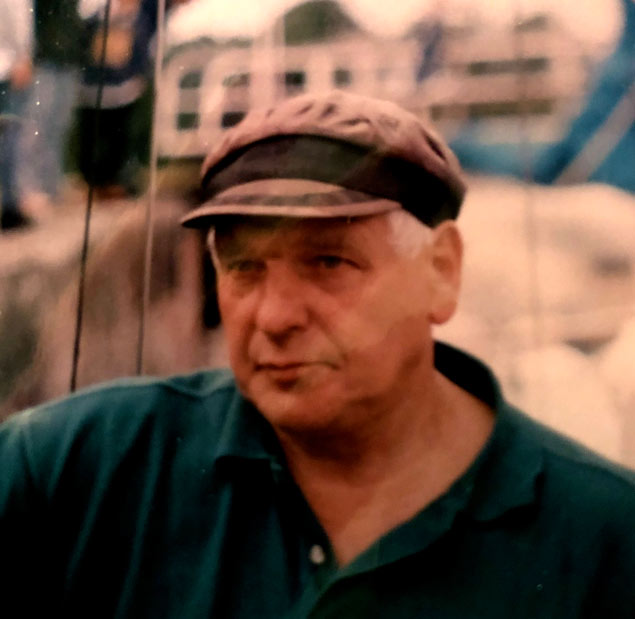 A man absorbed in his work. Fred Espey steering Hibernia into a lock chamber in the Caledonian Canal. Photo: Peter Fleming
A man absorbed in his work. Fred Espey steering Hibernia into a lock chamber in the Caledonian Canal. Photo: Peter Fleming
It was a passion which he has passed down the generations, as his eldest son David is one of the leading figures in the Classic Yachts movement, both in Dublin Bay and internationally. He and his siblings Alan and Helen have also seen the loss of their mother Eileen two-and-a-half years ago. Our heartfelt condolences are with them at this sad time and with Fred Espey’s ten grandchildren and his recently-arrived great-grandson James.
In his quiet yet determined way, Fred Espey was a very special one-off, and he will be much missed by his many friends in the sailing community.
WMN


























































